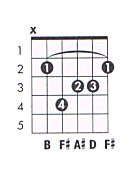


Look at a Dmin chord shape and look at the notes that make it up. Try these notes out together on your guitar and see what kind of sound you get. Once again, count up from D -> 7 semitones. Last but not least we need our perfect 5th. So lets count from D this time up 3 semitones. So looking back at the chart we see the distance between the root and the min 3rd is 3 semitones (tone and a half). So lets use the first minor chord in the C maj Chord pattern which is Dmin. So for this we need a Root, min 3rd, and a perfect 5th. So just keep that in mind.Īlright so next up we need the minor formula. Playing them in different orders and possitions can also change the over all tone or mood to the chord too. You can find these three notes anywhere on your fret board and play them together and that will give you a C maj chord. You should have pretty much C E G right? not nessaraly in that order but still the same notes. It would also be benifitial to look at the open C maj chord (if you already know it) and look at each of the notes in the chord. Lets find these notes on your guitar and see how it sounds. Count from C up 7 semitones and we get G! So now lets look back at our chart and count the difference between C and its Perfect fifth interval. So great now we have 2 out of the three notes we need to make this chord, the last part we need is our perfect 5th. We should be able to find then that E is 4 semitones or a Maj 3rd above C. Remember to take into consideration Enhamonic Equivalents. If you remember from the Intervals lesson, a major 3rd is 4 semitones more than its root. So now we need to count up a major third.

So lets look at C then and try to make a C major Chord. The Major Chord is made using a Root, Maj 3rd and Perfect 5th. So lets start with the formula to make a major chord. So now we know which chords will be Major and which will be minor. So let us assign each part of the chord pattern with a note from our scales: Maj. Note that the Chord pattern doesn't nessasarly dictate the quality of each interval but rather the quality of the Chord itself Whether they are Maj,min, or perfect intervals is to be determand by the Chord Pattern shown above. The three intervals we are interested in looking at in the momemnt are our Root, 3rd and 5th intervals. To make a Triad we need ( as the name implies with "Tri") Three intervals. Well the answer to that is actually quite simple. So What makes up a chord? Specifically a Triad? MajĪ bit confused as to how we got this? well let me explain a bit and hopefully it will become clearer as the lesson goes on. The Chord Pattern for a major key is as follows: Maj. So when we are looking at a major scale we have to take into account is how chord patterns work in any major key.
#MAJ MIN CHORDS HOW TO#
There you have it… a simple and easy way to convert any major chord into a minor chord.So Where Do I start with this? How about I talk a bit about how to make a Chord. If you’re only after a 3-fingered D minor triad, drop the highest note: Identify the 6th tone, which is D, and simply place that on the bottom: In the key of F, you’d take an F major chord: Let’s apply this principle to another key. Now, just in case you’re not wanting to play a fancy “A minor 7” and just want to play the basic “A minor” triad, drop the highest note (G) and you’ve got yourself a regular A minor triad: To convert this chord into its relative minor (that is, “A minor”), simply add the “6th” tone to the bottom of the chord. We call C major and A minor relative keys.Ī minor is the relative minor of C major. Simply play these same notes (don’t change a thing!) starting and ending on A and you’ve got yourself an “A minor” scale. If you turn each tone into a number (C is 1, D is 2, E is 3, F is 4, G is 5, A is 6, B is 7), you’ll quickly discover “A” is the 6th tone. Recall that in order to turn any major scale into its relative minor scale, you simply go to the 6th tone and play the same exact notes now starting and ending on that tone. What if I told you that playing minor chords was as easy as the trick we used to learn minor scales? They share the same number of sharps and flats in their scales (in this case, ZERO).Īnd, they share the same CHORDS! Major and Minor Chords Explored In other words, you can play the “A minor” scale if you already know the notes of the “C major” scale because they’re related.Ĭ major and A minor share the same notes. To pick up where we left off yesterday, I’d like to talk about the connection between major and minor chords.įrom yesterday‘s post, you now realize that you can form any minor scale by knowing the relative major scale it’s connected to.


 0 kommentar(er)
0 kommentar(er)
